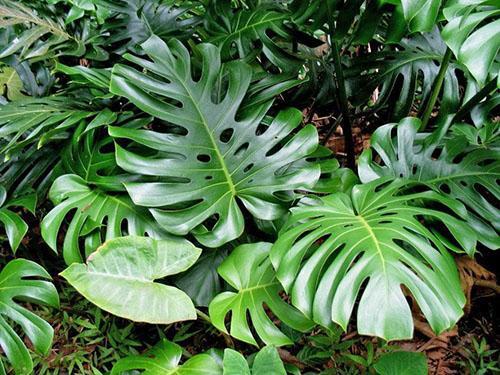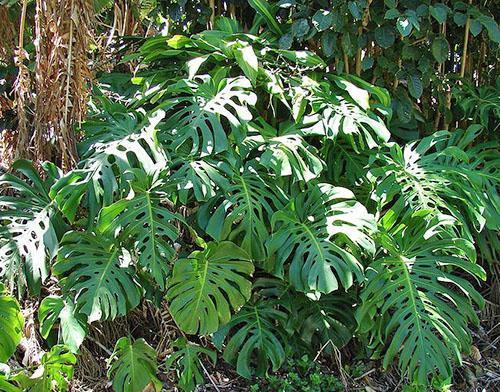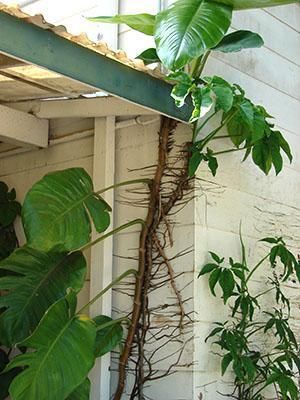Difficult nature and bright appearance of aroid indoor plants
 The largest collection of plants belonging to the aroid family is located in the botanical garden of the American state of Missouri. Despite the many years of collecting activity of the scientific team and the ongoing research work, it has not yet been possible to plant and raise all the representatives of the aroids.
The largest collection of plants belonging to the aroid family is located in the botanical garden of the American state of Missouri. Despite the many years of collecting activity of the scientific team and the ongoing research work, it has not yet been possible to plant and raise all the representatives of the aroids.
Yes, this is probably impossible. According to the existing classification, the largest family today includes 113 genera and almost two thousand species. The bulk of these plants, among which there are treelike and herbaceous specimens, epiphytes and marsh inhabitants, lianas, giant and tiny species, live in the subtropics and tropics. But there are also known species that prefer to settle in a temperate climate, inhabiting rather harsh areas, up to the subarctic regions.
The history of the study and description of aroids began in the Middle Ages. The first who in written works mentioned individual plants of this family was Theophrastus, but until the 16th century there were no attempts to classify or combine closely related species. It was only in 1789 that Antoine Laurent de Jussier, in describing his own view of plant families, declared the existence of common features of the aroids.

So what are aroid plants? What common features do they have, and what types are well known to flower growers keen on decorative indoor crops?
Aroid plants: what are they?
 Most plants of the aroid family are distinguished by the almost complete absence of real stems, whose functions are performed by modified rhizomes. The only exceptions are lianas, thanks to their tenacious aerial roots, they can easily climb vertical surfaces and master larger plants for habitation.
Most plants of the aroid family are distinguished by the almost complete absence of real stems, whose functions are performed by modified rhizomes. The only exceptions are lianas, thanks to their tenacious aerial roots, they can easily climb vertical surfaces and master larger plants for habitation.
Interestingly, such aerial roots, as in one of the varieties of epipremnum, not only help maintain heavy long shoots, but also nourish the plant, absorbing atmospheric moisture, and, if possible, rooting.
Therefore, when growing indoor aroid plants, they are by no means removed, but, on the contrary, are used for feeding and maintaining the viability of long shoots.
 The leaves of wild and indoor aroid plants are formed alternately. Moreover, in most species the presence of a pronounced petiole is observed, and the leaf plates are striking in a variety of sizes, colors and shapes, as in the indoor aroid plant presented in the photo with the name Caladium, which has earned worldwide recognition. In addition to uniformly colored whole leaves, in aroids one can find intricately dissected, corrugated, variegated and unusually structured leaf plates.
The leaves of wild and indoor aroid plants are formed alternately. Moreover, in most species the presence of a pronounced petiole is observed, and the leaf plates are striking in a variety of sizes, colors and shapes, as in the indoor aroid plant presented in the photo with the name Caladium, which has earned worldwide recognition. In addition to uniformly colored whole leaves, in aroids one can find intricately dissected, corrugated, variegated and unusually structured leaf plates.
It is thanks to this diversity and brightness that interest was shown to the representatives of the family as indoor, ornamental plants.
 As for flowering, unlike foliage, which is striking in its quirkiness of forms, there is no variety here. All aroid plants, whether indoor or naturally occurring species, form a cob-shaped inflorescence of very densely spaced small flowers. At the same time, the line between male and female flowers is clearly visible on the cob. However, in some species the flowers are bisexual.
As for flowering, unlike foliage, which is striking in its quirkiness of forms, there is no variety here. All aroid plants, whether indoor or naturally occurring species, form a cob-shaped inflorescence of very densely spaced small flowers. At the same time, the line between male and female flowers is clearly visible on the cob. However, in some species the flowers are bisexual.
 With a common structure of inflorescences, their appearance and size can vary significantly, and most of them often give the impression of a large single flower, misleading both lovers of domestic plants, and even insects that pollinate such inflorescences.
With a common structure of inflorescences, their appearance and size can vary significantly, and most of them often give the impression of a large single flower, misleading both lovers of domestic plants, and even insects that pollinate such inflorescences.
The perianth gives the inflorescence decorativeness and resemblance to a flower, depending on the type and variety of the plant, which has different colors, shapes and sizes. Flowering is often extremely surprising. And people who are not dedicated in particular to aroid plants ask: "What is this?" In fact, this is not an exotic orchid, or a skillful creation of a jeweler, but an anaphyllum inflorescence from India.
 This giant inflorescence, which got into the Book of Records, belongs to the giant amorphophallus. The size of the cob, which unites up to five thousand flowers, in this case reaches 2–3 meters and protrudes high beyond the purple-green perianth.
This giant inflorescence, which got into the Book of Records, belongs to the giant amorphophallus. The size of the cob, which unites up to five thousand flowers, in this case reaches 2–3 meters and protrudes high beyond the purple-green perianth.
In the inflorescence of the pistia there are much fewer flowers, only 5–9, and the size here does not exceed 10 mm. Almost the same inconspicuous inflorescence gives another type of aroid plants - ragweed.
In most species of naturally occurring and indoor aroid plants, the perianth partially or completely hides the ear, performing a protective function and, at the same time, attracting the attention of pollinating insects to the inflorescence.
 At the same time, evolution went so far that plants with trap blankets appeared, allowing insects to be kept near the female flowers until the pollination process was successfully completed.
At the same time, evolution went so far that plants with trap blankets appeared, allowing insects to be kept near the female flowers until the pollination process was successfully completed.
 The peculiar deception of insects is not limited to the special form of the bedspread or its bright colors, like that of anthurium, an aroid indoor plant, whose name and photo are well known to flower growers.
The peculiar deception of insects is not limited to the special form of the bedspread or its bright colors, like that of anthurium, an aroid indoor plant, whose name and photo are well known to flower growers.
 Certain plants in the large family give off an attractive aroma. An example of this is the beloved calla lilies.
Certain plants in the large family give off an attractive aroma. An example of this is the beloved calla lilies.
 But there are plants that attract a specific group of pollinators - flies. Therefore, these types have to resort to completely unexpected methods and measures. A rare feature of aroids is the ability to raise the temperature of the cob to 30–45 ° C, so that volatile aromatic substances begin to actively evaporate from the heated surface of the flowers, spreading a strong smell of carrion around for several hours.
But there are plants that attract a specific group of pollinators - flies. Therefore, these types have to resort to completely unexpected methods and measures. A rare feature of aroids is the ability to raise the temperature of the cob to 30–45 ° C, so that volatile aromatic substances begin to actively evaporate from the heated surface of the flowers, spreading a strong smell of carrion around for several hours.
This technique is "used" not only by the already mentioned titanic amorphophallus, but also by Symplocarpus foetidus, Helicodiceros muscivorus and Sauromatum venosum, the flowering of which is shown in the photo. Interestingly, despite the smell, this aroid plant is an indoor plant that is popular with lovers of exotic species.
At the same time, it is important for flower growers interested in this family to remember that aroid indoor plants are poisonous. In all parts of the plant, from tubers, rhizomes and stems, to leaves and inflorescences, calcium oxalate is contained, which has a sharp irritating effect on the skin and mucous membranes.
 In different species, the concentration of this substance may differ, but when caring for aroid indoor plants, as in the photo, accompanied by direct contact, it is better to use gloves and wash your hands after completing the work.
In different species, the concentration of this substance may differ, but when caring for aroid indoor plants, as in the photo, accompanied by direct contact, it is better to use gloves and wash your hands after completing the work.
Photos and names of indoor aroid plants
 Thanks to their spectacular appearance, many varieties of aroids are indoor plants that are loved by a multi-million army of amateur flower growers.
Thanks to their spectacular appearance, many varieties of aroids are indoor plants that are loved by a multi-million army of amateur flower growers.
Among the many photos and names of indoor plants of the Aroid family, connoisseurs will certainly note anthurium with glossy dense bracts of all shades of purple, scarlet, pink, and now also white.
 A variety of varieties enjoy the sincere love of flower growers. spathiphyllum, differing in the size of the plants themselves and graceful white inflorescences.
A variety of varieties enjoy the sincere love of flower growers. spathiphyllum, differing in the size of the plants themselves and graceful white inflorescences.
 Monsters, philodrendrons and large species of alocasia attract attention with extremely unusual foliage, however, to grow such crops, a florist will have to find a fairly spacious room, because large specimens can show true beauty. But small alocasia are quite appropriate both in a residential interior and in a public building.
Monsters, philodrendrons and large species of alocasia attract attention with extremely unusual foliage, however, to grow such crops, a florist will have to find a fairly spacious room, because large specimens can show true beauty. But small alocasia are quite appropriate both in a residential interior and in a public building.
 Aglaonema does not have carved foliage and does not stand out for its bright flowering, but the palette of any artist will envy the colors of its heart-shaped foliage.
Aglaonema does not have carved foliage and does not stand out for its bright flowering, but the palette of any artist will envy the colors of its heart-shaped foliage.
 The same can be said about the leaves of such an indoor aroid plant as the caladium.
The same can be said about the leaves of such an indoor aroid plant as the caladium.
 In addition to multi-meter giants, and plants suitable for growing in indoor pots, there are real dwarfs in the family. For example, pistia is a plant in demand by hobbyists, with a rosette not exceeding 10-15 cm in diameter.
In addition to multi-meter giants, and plants suitable for growing in indoor pots, there are real dwarfs in the family. For example, pistia is a plant in demand by hobbyists, with a rosette not exceeding 10-15 cm in diameter.
 Popular indoor culture is and syngonium... This is a fast-growing climbing plant from the aroid family, forming well-leafy shoots. The syngonium is interesting for the graceful form of foliage and its variegated color, which changes as the plant develops.
Popular indoor culture is and syngonium... This is a fast-growing climbing plant from the aroid family, forming well-leafy shoots. The syngonium is interesting for the graceful form of foliage and its variegated color, which changes as the plant develops.
 Speaking of the family, one cannot but recall Dieffenbachia, which has become a classic potting culture and has not left the collection of gardeners for many years. The appearance of variegated varieties, as in the photo, and the simple care of an indoor aroid plant helps to maintain popularity.
Speaking of the family, one cannot but recall Dieffenbachia, which has become a classic potting culture and has not left the collection of gardeners for many years. The appearance of variegated varieties, as in the photo, and the simple care of an indoor aroid plant helps to maintain popularity.
 Rafidofora with medium-sized expressive foliage and long shoots that can climb practically sheer bare walls is not yet very well known to flower growers.
Rafidofora with medium-sized expressive foliage and long shoots that can climb practically sheer bare walls is not yet very well known to flower growers.
Most of the species intended and actively used in indoor floriculture, represented by many varieties and hybrids. But with such a wide variety, aroids in nature live in similar conditions, therefore, caring for them consists of close activities.
Aroid: photo and care at home
 All indoor aroid plants do not tolerate sudden temperature changes, and react to cold air currents, for example, from a draft, with spots on the foliage and a decrease in the turgor of the aboveground part. If the culture is in the cold for a long time, it can shed the foliage, mistaking the cold snap for the beginning of the winter period.
All indoor aroid plants do not tolerate sudden temperature changes, and react to cold air currents, for example, from a draft, with spots on the foliage and a decrease in the turgor of the aboveground part. If the culture is in the cold for a long time, it can shed the foliage, mistaking the cold snap for the beginning of the winter period.
If in the summertime aroid needs a fairly frequent and abundant watering, and some species perfectly exist in the aquatic environment, then in winter, watering is reduced. Restrained year-round watering is needed only for zamiakulkas.
 All plants from this family are demanding on the soil. It should be lightweight, loose, well permeable to both water and oxygen. When choosing a mixture for plants, use the bark of coniferous trees, pre-boiled and crushed, coconut fiber, sphagnum and perlite, as well as sand and peat.
All plants from this family are demanding on the soil. It should be lightweight, loose, well permeable to both water and oxygen. When choosing a mixture for plants, use the bark of coniferous trees, pre-boiled and crushed, coconut fiber, sphagnum and perlite, as well as sand and peat.
In summer, aroid plants in the room are placed so that the pets have a lot of light, but the rays of the sun do not burn the juicy foliage and stems. In winter, a lot of light is also required, and if it is lacking, artificial lighting is used.
Propagate species belonging to the aroid family. the easiest way is by vegetative methods, for example, with daughter tubers, like alocasia, or by dividing a bush, like spathiphyllums.
At the same time, do not forget about the toxicity of indoor aroid plants, which are not recommended to be placed in a place accessible to small children and pets living in the house.
What is this flower
This is how the philodendron blooms.